TROUT FROM STILL WATERS - The Scottish Approach
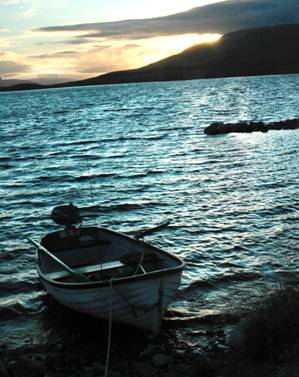 Loch style fishing has been done on the Scottish lochs for many, many years. It doesn't only work here but on any still water, all that is needed is a little wind.
Loch style fishing has been done on the Scottish lochs for many, many years. It doesn't only work here but on any still water, all that is needed is a little wind.
Some years ago a couple of friends of mine visited Hebgen Lake in Yellowstone. The local advice was to motor to the inlets and look for "gulpers". No one was having good sport at that time. Instead they fished "loch style" from a drifting boat. In the half day they fished over 50 trout came to their two rods.
Though our lochs are not as large as Hebgen Lake, they are large sheets of water, which can be intimidating when you first go to fish them. Having a technique that will let you cover a lot of water will give you more chance of finding and catching fish.
Loch Landsaidh
Deploying a drogue
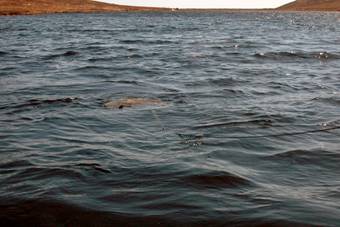 What you will need is a boat, a drogue (underwater parachute used to slow the boat, usually about 50 inches square, see the picture to the left). A long rod, 9' to 12' rated from 5 to 8 weight, the longer the better. If, like me, you are tall, then a thwart board makes the day a lot more comfortable. A simple plank of wood that is long enough to sit across the thwarts of the boat will do. You need to be able to sit astride it so it shouldn't be wider than about 10 inches.
What you will need is a boat, a drogue (underwater parachute used to slow the boat, usually about 50 inches square, see the picture to the left). A long rod, 9' to 12' rated from 5 to 8 weight, the longer the better. If, like me, you are tall, then a thwart board makes the day a lot more comfortable. A simple plank of wood that is long enough to sit across the thwarts of the boat will do. You need to be able to sit astride it so it shouldn't be wider than about 10 inches.
If you see trout rising then you need to position the boat well up wind of them, motor, or row, around them in a wide arc. Then turn the boat so it is side on to the wind. If the boat is drifting quickly deploy your drogue to slow your drift. Sit astride the seat, or thwart board, and cast over the downwind side of the boat. As the boat drifts toward your flies move them through the water by retrieving line and by raising your rod. As you raise your rod the flies will break the surface. Let them dangle (or "dibble" as we say here) in the surface film, this will often bring a fish up. Then lift off and cast again. Flies for this technique tend to be very bushy; you want them to move a lot of water. Traditional flies like the Soldier Palmer, Kate McLaren, Zulu series, are typically used.
Loch Style flies.
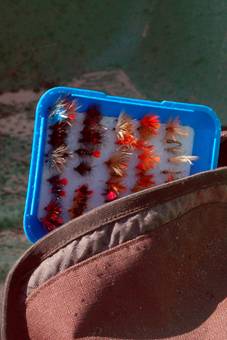
It is normal to use a team of three flies for loch style fishing, though sometimes four are used. They are tied to droppers attached to the main leader line. They should be 4 to 6 feet apart. A typical "cast", as it is called here, would be a 9' knotless tapered leader followed by 9' to 13' of level mono with two or three droppers attached. The bushiest fly goes on the top dropper (nearest the fly line), and the slimmest on the point of the leader.
I find that keeping droppers down to an inch or two long reduces tangles.
Etiquette of Boat Fishing
Don't cast at the same time as your partner. Try to alternate your casting. If you see your boat partner is about to lift off, don't start to cast.
Imagine a line between the rowlocks that extends outside the boat. Everything to your side of the boat is your water. Everything to the other side of that line is your boat partner's water. Don't poach his water.
Turn the boat at the end of every drift. (Unless you are lucky enough to have a right handed and left handed combination.) If both of you are right handed, or both left handed, one of you will have to cast across the wrong shoulder, making casting more difficult. It is only fair to share this.
Safety note
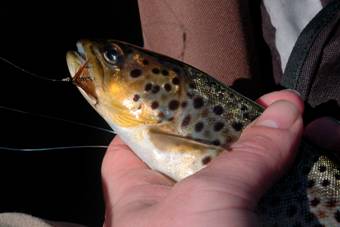
Don't stand in a drifting boat. Unless you want to be outside the boat! (Should you find yourself outside the boat don't try to get back in over the side. Go to the stern and climb in that way.)
The reward for good loch style fishing, a wild brown trout from a Highland loch, taken on the middle dropper.
This is an introduction to traditional loch style fishing. There are many variations that have been developed.
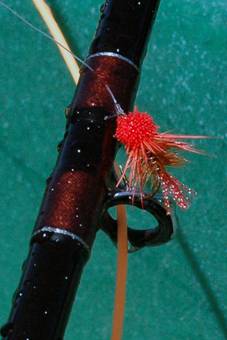 Next time I'll go through some of the flies we use.
Next time I'll go through some of the flies we use.
